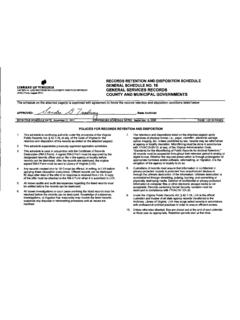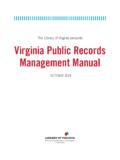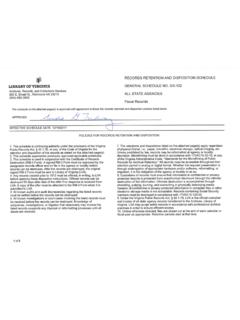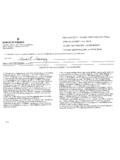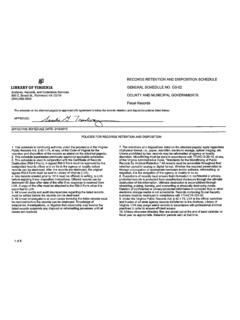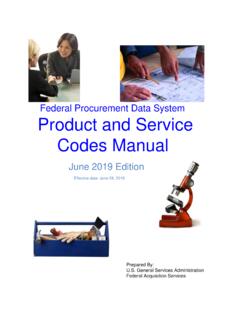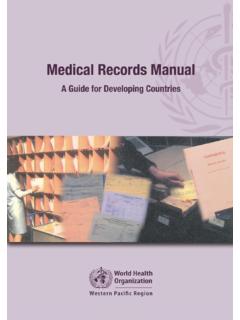Transcription of The Library of Virginia presents Virginia Public Records ...
1 The Library of Virginia presents Virginia Public Records management manual ber 2014. 800 East Broad n Richmond, Virginia 23219. Table of contents Chapter 1: Basics of a Records management Program 5. Records management Objectives 5. Benefits 5. What Is a Public record ? 6. Designating a Records Officer 6. Starting a Records management Program 7. Delivery of Records to Successor 8. Legal Authority 8. Chapter 2: Files management 9. Designing a File Plan 9. Filing Practices 9. Alphabetical Filing 9. Numerical Filing 10. Alphanumeric Filing 10. Network Drives 10. Filing Cutoffs 10. Indexes 11. Tracking Paper Files 11. Chapter 3: Records Emergency Planning 12. Responsibilities for Planning 12. Continuity of Operations Plans (COOP) 12. Indentifying and Protecting Essential Records 12. Creating a Records Emergency Action Plan (REAP) 13. Off-site Storage 13. Chapter 4: Records Retention and Disposition Schedules 14.
2 Benefits of a Retention Schedule 14. Creating and Updating General Schedules 14. Creating and Updating Specific Schedules 15. Making the Schedule Legal 15. Submission Deadlines and Calendar 15. Composition and Appearance of the Schedules 16. Applying Retention Schedules 17. Chapter 5: Records Inventory and Records Survey 18. Records Inventory 18. Records Survey (RM-19 Form) for State Agencies 18. Approaching the Records Survey Process 18. Evaluating Records for the Records Survey 19. Chapter 6: Electronic Records 20. Storage Media 20. File Formats 21. File Naming 21. Metadata 22. Migration and Conversion 22. E-mail management 23. Website management 23. Chapter 7: Reformatting Records 25. When to Reformat 25. Reformatting Options 25. Legality of Reformatted Records 26. Destroying Originals after Reformatting 27. Chapter 8: Records Destruction 28. Destruction and Reformatting 28.
3 Destruction Hold 28. Determining Date of Destruction 29. Destruction Process 29. Methods of Destruction 30. Importance of Documenting Records Destruction 30. Chapter 9: Records Preservation 31. Chapter 10: Records Storage 33. Environmental and Security Concerns 33. Storage System Integrity 33. Storage Boxes and Shelving 33. Packing and Stacking Boxes 33. Centralized Storage Facility 34. Chapter 11: State Records Center Transfers and Services 35. Eligibility for State Records Center Storage 35. Access and Ownership 35. Storage Fees and Service Charges 35. Transfer Procedures for Nonpermanent Records 36. Requesting Records 36. Returning Records 37. Destruction of Records at the SRC 37. Pest Eradication and Blast Freezing 37. Chapter 12: Archival Transfer Procedures 38. Caring for Archival Records during their Active Life Cycle 38. Preparing Records for Transfer 38.
4 Archival Transfer Forms 39. Physical Transfer 39. Accessing Records in the Archives 40. Chapter 13: Microform Transfers and Procedures 41. Caring for Microform Records 41 Preparing to Transfer Microforms 41. Chapter 14: The Role of Archives, Records , and Collection management Services at the Library of Virginia 43. Records Analysis Section (RAS) 43. Description Services 43. Local Records Services 43. Imaging Services 43. State Records Center (SRC) 44. Chapter 15: Conducting Compliance Reviews (Audits) 45. Establishing a Compliance Review Program 45. Determining Responsibility for Compliance Reviews 45. Defining the Scope of a Compliance Review 45. Compliance Review Components 46. Reporting Compliance Review Findings 47. Glossary 48. Chapter 1: Basics of a Records management Program The Virginia Public Records Act (VPRA) et seq. establishes a single body of law applicable to all Public officers and employees to ensure that the procedures used to manage and preserve Public Records will be uniform throughout the commonwealth.
5 A Public Records management program is implemented in order to: n Aid and assist custodians of Public Records in making informed judgments about policy. n Enable citizens to judge the conduct of the government by providing administrative, fiscal, and legal accountability. n Allow information to be open for observation and access, while safeguarding privacy and confidentiality. n Ensure the documentation of government actions. n Maintain good business practices. In addition to being a mandate of the Code of Virginia , following sound Records management practices is good business. Public officials are legally responsible for creating and maintaining Records that document the transactions of government. These Records provide evidence of the operations of government and accountability to its citizens. Public officials must maintain this information according to established Records retention and disposition schedules regardless of record format.
6 The content of a document determines whether it is a Public record and how it is to be retained. Records management Objectives Records management is the economical and effective administrative process for managing information and ensuring access throughout its life cycle, from creation to destruction or preservation. To create and maintain an effective Records management program, each government entity must: n Designate at least one Records officer through submission of the Records Officer Designation and Responsibilities (RM-25 Form). n Develop policies and procedures for Records management . n Conduct a survey or inventory of Records in all formats. n Establish and follow Library of Virginia approved Records retention and disposition schedules. n Use technology, as appropriate, to create, store, and retrieve Records . n Destroy Records at the end of their retention period and document that destruction.
7 N Store inactive Records in a cost-effective and secure location. n Identify and protect essential Records . n Identify and preserve permanent Records . n Develop a Records emergency response plan to protect and recover all Records . n Implement filing and indexing systems. Benefits An effective Records management program will: n Reduce the volume of Records stored by destroying Records that have reached the end of their retention. n Increase the efficiency of office operations through better storage and retrieval systems. n Reduce costs for equipment, supplies, space, and personnel. n Identify and protect essential Records . 5. n Improve accountability of Public funds. n Reduce liability risks by keeping Records according to retention schedules. What Is a Public record ? The VPRA defines a Public record as: information that documents a transaction or activity by or with any Public officer, agency or employee of an agency.
8 Regardless of physical form or characteristic, the recorded information is a Public record if it is produced, collected, received or retained in pursuance of law or in connection with the transaction of Public business. The medium upon which such information is recorded has no bearing on the determination of whether the recording is a Public record . Code of Virginia Public Records , except for those exempt under the Virginia Freedom of Information Act (FOIA), must be available for access throughout their retention periods per Code of Virginia et seq. A record that is considered FOIA-exempt is not exempt from the requirements of the VPRA. Records containing confidential information are still Public Records . Designating a Records Officer The VPRA states that each agency and political subdivision shall designate as many as appropriate, but at least one, Records officer to serve as a liaison to the Library of Virginia for the purposes of implementing and overseeing a Records management program, and coordinating legal disposition, including destruction of obsolete Records .
9 For the purposes of this manual , political subdivision and locality shall mean the same, and include all local government entities, regional authorities, and political subdivisions within the Commonwealth of Virginia . The designated Records officer (RO) should have the support of senior/executive management and should retain a position of influence within the agency or locality. The duties of the RO will require a substantial time commitment. Carefully consider the following points when appointing an RO. The employee designated as RO must have the time and the ability to: n Manage an agency-wide Records management program to include the storage, retrieval, retention, and disposition of Public Records . n Create agency-specific procedures that provide direction on complying with these mandated Records management functions. n Provide training to, and routinely educate, staff on these procedures.
10 N Identify essential and archival Records and ensure that those Records are properly maintained, protected, and accessible. n Coordinate the development of a Records emergency response plan for the protection/recovery of Records in the event of a disaster. n Work with departments, including Information Technology, to identify and implement electronic Records solutions and participate in decisions concerning Records reformatting. 6. n Conduct Records audits to ensure compliance with Library of Virginia approved Records retention and disposition schedules and agency procedures. These responsibilities must be clearly outlined and reflected in the Records officer's job description or employee work profile. A minimum of 20 percent of the Records officer's time, or eight hours a week, should be dedicated to fulfilling these responsibilities. Designate the person or persons who will serve as Records officer(s) by mailing the Records Officer Designation and Responsibilities (RM-25 Form) to the Library .
